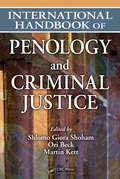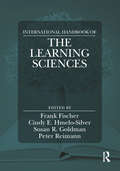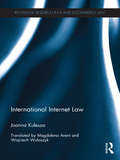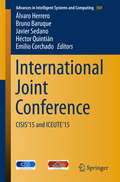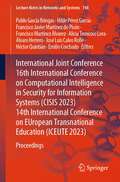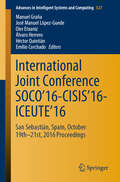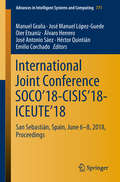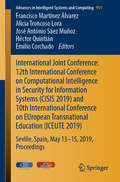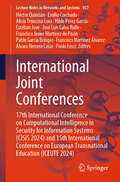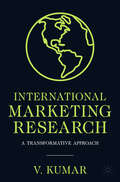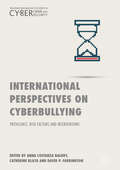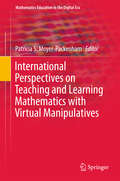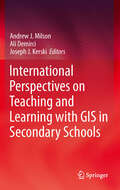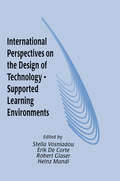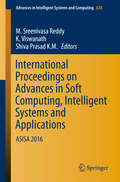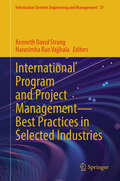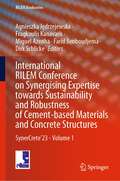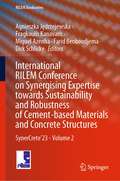- Table View
- List View
International Handbook of Penology and Criminal Justice
by Shlomo Giora Shoham Martin Kett Ori BeckAt the outset of the twenty-first century, more than 9 million people are held in custody in over 200 countries around the world.--from the essay "Prisons and Jails" by Ron KingThe first comparative study of this increasingly integral social subject, International Handbook of Penology and Criminal Justice provides a comprehensive and balanced revie
International Handbook of the Learning Sciences
by Peter Reimann Frank Fischer Cindy E. Hmelo-Silver Susan R. GoldmanThe International Handbook of the Learning Sciences is a comprehensive collection of international perspectives on this interdisciplinary field. In more than 50 chapters, leading experts synthesize past, current, and emerging theoretical and empirical directions for learning sciences research. The three sections of the handbook capture, respectively: foundational contributions from multiple disciplines and the ways in which the learning sciences has fashioned these into its own brand of use-oriented theory, design, and evidence; learning sciences approaches to designing, researching, and evaluating learning broadly construed; and the methodological diversity of learning sciences research, assessment, and analytic approaches. This pioneering collection is the definitive volume of international learning sciences scholarship and an essential text for scholars in this area.
International Internet Law (Routledge Research in Information Technology and E-Commerce Law)
by Joanna KuleszaThis book discusses the international legal issues underlying Internet Governance and proposes an international solution to its problems. The book encompasses a wide spectrum of current debate surrounding the governance of the internet and focuses on the areas and issues which urgently require attention from the international community in order to sustain the proper functioning of the global network that forms the foundation of our information fuelled society. Among the topics discussed are international copyright protection, state responsibility for cyber-attacks (cyberterrorism), and international on-line privacy protection. Taking a comparative approach by examining how different jurisdictions such as the United States, the European Union, China and Singapore have attempted various solutions to the problem of Internet Governance, the author offers a practical solution to the problem and is a proponent of International Internet Law. Kulesza suggests that just as in the case of International Environmental Law, an Internet Framework Convention could shape the starting point for international cooperation and lead to a clear, contractual division of state jurisdictional competences. International Internet Law is of particular interest to legal scholars engaged with the current challenges in international law and international relations, as well as students of law, international relations and political science. The issues discussed in the book are also relevant to journalists and other media professionals, facing the challenges of analyzing current international developments in cyberspace.
International Joint Conference
by Bruno Baruque Álvaro Herrero Javier Sedano Héctor Quintián Emilio CorchadoThis volume of Advances in Intelligent and Soft Computing contains accepted papers presented at the 8th International Conference on Computational Intelligence in Security for Information Systems (CISIS 2015) and the 6th International Conference on European Transnational Education (ICEUTE 2015). These conferences were held in the beautiful and historic city of Burgos (Spain), in June 2015. The aim of the 8th CISIS conference is to offer a meeting opportunity for academic and industry-related researchers belonging to the various, vast communities of Computational Intelligence, Information Security, and Data Mining. The need for intelligent, flexible behaviour by large, complex systems, especially in mission-critical domains, is intended to be the catalyst and the aggregation stimulus for the overall event. After a through peer-review process, the CISIS 2015 International Program Committee selected 43 papers, written by authors from 16 different countries. In the case of 6th ICEUTE conference, the International Program Committee selected 12 papers (from 7 countries). These papers are published in present conference proceedings, achieving an acceptance rate of about 39%. The selection of papers was extremely rigorous in order to maintain the high quality of the conference and we would like to thank the members of the Program Committees for their hard work in the reviewing process. This is a crucial process to the creation of a high standard conference and the CISIS and ICEUTE conferences would not exist without their help.
International Joint Conference 15th International Conference on Computational Intelligence in Security for Information Systems: Proceedings (Lecture Notes in Networks and Systems #532)
by Álvaro Herrero Héctor Quintián Emilio Corchado Francisco Javier Martínez de Pisón Hilde Pérez García Enrique A. de la Cal Francisco Martínez Álvarez Alicia Troncoso Lora Pablo García Bringas José Ramón Villar Flecha Giuseppe PsailaThis book of Lecture Notes in Networks and Systems contains accepted papers presented at the 15th International Conference on Computational Intelligence in Security for Information Systems (CISIS 2022) and the 13th International Conference on EUropean Transnational Education (ICEUTE 2022). These conferences were held in the beautiful city of Salamanca, Spain, in September 2022. The aim of the CISIS 2022 conference is to offer a meeting opportunity for academic and industry-related researchers belonging to the various, vast communities of computational intelligence, information security, and data mining. The need for intelligent, flexible behaviour by large, complex systems, especially in mission-critical domains, is intended to be the catalyst and the aggregation stimulus for the overall event. After a thorough peer review process, the CISIS 2022 International Program Committee selected 20 papers, which are published in this conference proceedings. In this edition, three special sessions were organized: Cybersecurity in Future Connected Societies, Cybersecurity and Trusted Supply Chains of ICT, and Intelligent Solutions for Cybersecurity Systems. The aim of ICEUTE 2022 is to offer a meeting point for people working on transnational education within Europe. It provides a stimulating and fruitful forum for presenting and discussing the latest works and advances on transnational education within European countries. In the case of ICEUTE 2022, the International Program Committee selected 5 papers, which are also published in this conference proceedings. The selection of papers was extremely rigorous to maintain the high quality of the conferences. We want to thank the members of the Program Committees for their hard work during the reviewing process. This is a crucial process for creating a high-standard conference; the CISIS and ICEUTE would not exist without their help.
International Joint Conference 16th International Conference on Computational Intelligence in Security for Information Systems: Proceedings (Lecture Notes in Networks and Systems #748)
by Álvaro Herrero Héctor Quintián Emilio Corchado Francisco Javier Martínez de Pisón Hilde Pérez García Francisco Martínez Álvarez Alicia Troncoso Lora Pablo García Bringas José Luis Calvo RolleThis book of Lecture Notes in Networks and Systems contains accepted papers presented at the 16th International Conference on Computational Intelligence in Security for Information Systems (CISIS 2023) and the 14th International Conference on EUropean Transnational Education (ICEUTE 2023). These conferences were held in the beautiful city of Salamanca, Spain, in September 2023.The aim of the CISIS 2023 conference is to offer a meeting opportunity for academic and industry-related researchers belonging to the various, vast communities of computational intelligence, information security, and data mining. The need for intelligent, flexible behavior by large, complex systems, especially in mission-critical domains, is intended to be the catalyst and the aggregation stimulus for the overall event. The aim of ICEUTE 2023 conference is to offer a meeting point for people working on transnational education within Europe. It provides a stimulating and fruitful forum for presenting and discussing the latest works and advances on transnational education within European countries.
International Joint Conference SOCO’16-CISIS’16-ICEUTE’16
by Manuel Graña Álvaro Herrero Héctor Quintián Emilio Corchado José Manuel López-Guede Oier EtxanizThis volume of Advances in Intelligent and Soft Computing contains accepted papers presented at SOCO 2016, CISIS 2016 and ICEUTE 2016, all conferences held in the beautiful and historic city of San Sebasti#65533;n (Spain), in October 2016. Soft computing represents a collection or set of computational techniques in machine learning, computer science and some engineering disciplines, which investigate, simulate, and analyze very complex issues and phenomena. After a through peer-review process, the 11th SOCO 2016 International Program Committee selected 45 papers. In this relevant edition a special emphasis was put on the organization of special sessions. Two special session was organized related to relevant topics as: Optimization, Modeling and Control Systems by Soft Computing and Soft Computing Methods in Manufacturing and Management Systems. The aim of the 9th CISIS 2016 conference is to offer a meeting opportunity for academic and industry-related researchers belonging to the various, vast communities of Computational Intelligence, Information Security, and Data Mining. The need for intelligent, flexible behaviour by large, complex systems, especially in mission-critical domains, is intended to be the catalyst and the aggregation stimulus for the overall event. After a through peer-review process, the CISIS 2016 International Program Committee selected 20 papers. In the case of 7th ICEUTE 2016, the International Program Committee selected 14 papers.
International Joint Conference SOCO’16-CISIS’16-ICEUTE’16: San Sebastián, Spain, October 19th-21st, 2016 Proceedings (Advances in Intelligent Systems and Computing #527)
by Manuel Graña Álvaro Herrero Héctor Quintián Emilio Corchado José Manuel López-Guede Oier EtxanizThis volume of Advances in Intelligent and Soft Computing contains accepted papers presented at SOCO 2016, CISIS 2016 and ICEUTE 2016, all conferences held in the beautiful and historic city of San Sebastián (Spain), in October 2016.Soft computing represents a collection or set of computational techniques in machine learning, computer science and some engineering disciplines, which investigate, simulate, and analyze very complex issues and phenomena.After a through peer-review process, the 11th SOCO 2016 International Program Committee selected 45 papers. In this relevant edition a special emphasis was put on the organization of special sessions. Two special session was organized related to relevant topics as: Optimization, Modeling and Control Systems by Soft Computing and Soft Computing Methods in Manufacturing and Management Systems.The aim of the 9th CISIS 2016 conference is to offer a meeting opportunity for academic and industry-related researchers belonging to the various, vast communities of Computational Intelligence, Information Security, and Data Mining. The need for intelligent, flexible behaviour by large, complex systems, especially in mission-critical domains, is intended to be the catalyst and the aggregation stimulus for the overall event.After a through peer-review process, the CISIS 2016 International Program Committee selected 20 papers. In the case of 7th ICEUTE 2016, the International Program Committee selected 14 papers.
International Joint Conference SOCO’17-CISIS’17-ICEUTE’17 León, Spain, September 6–8, 2017, Proceeding
by Héctor Quintián Emilio Corchado Hilde Pérez García Javier Alfonso-Cendón Lidia Sánchez GonzálezThis volume includes papers presented at SOCO 2017, CISIS 2017, and ICEUTE 2017, all conferences held in the beautiful and historic city of León (Spain) in September 2017.Soft computing represents a collection of computational techniques in machine learning, computer science, and some engineering disciplines, which investigate, simulate, and analyze highly complex issues and phenomena.These proceedings feature 48 papers from the 12th SOCO 2017, covering topics such as artificial intelligence and machine learning applied to health sciences; and soft computing methods in manufacturing and management systems.The book also presents 18 papers from the 10th CISIS 2017, which provided a platform for researchers from the fields of computational intelligence, information security, and data mining to meet and discuss the need for intelligent, flexible behavior by large, complex systems, especially in mission-critical domains. It addresses various topics, like identification, simulation and prevention of security and privacy threats in modern communication networks Furthermore, the book includes 8 papers from the 8th ICEUTE 2017. The selection of papers for all three conferences was extremely rigorous in order to maintain the high quality and we would like to thank the members of the Program Committees for their hard work in the reviewing process.
International Joint Conference SOCO’18-CISIS’18-ICEUTE’18: San Sebastián, Spain, June 6-8, 2018 Proceedings (Advances in Intelligent Systems and Computing #771)
by Manuel Graña Álvaro Herrero Héctor Quintián Emilio Corchado José Manuel López-Guede Oier Etxaniz José Antonio SáezThis book includes papers presented at SOCO 2018, CISIS 2018 and ICEUTE 2018, all held in the beautiful and historic city of San Sebastian (Spain), in June 2018. Soft computing represents a collection or set of computational techniques in machine learning, computer science and some engineering disciplines, which investigate, simulate, and analyze highly complex issues and phenomena. After a rigorous peer-review process, the 13th SOCO 2018 International Program Committee selected 41 papers, with a special emphasis on optimization, modeling and control using soft computing techniques and soft computing applications in the field of industrial and environmental enterprises. The aim of the 11th CISIS 2018 conference was to offer a meeting opportunity for academic and industry researchers from the vast areas of computational intelligence, information security, and data mining. The need for intelligent, flexible behaviour by large, complex systems, especially in mission-critical domains, was the catalyst for the overall event.Eight of the papers included in the book were selected by the CISIS 2018 International Program Committee. The International Program Committee of ICEUTE 2018 selected 11 papers for inclusion in these conference proceedings.
International Joint Conference: Seville, Spain, May 13th-15th, 2019 Proceedings (Advances in Intelligent Systems and Computing #951)
by Héctor Quintián Emilio Corchado Francisco Martínez Álvarez Alicia Troncoso Lora José António Sáez MuñozThis volume presents papers presented at CISIS 2019 and ICEUTE 2019, held in the beautiful and historic city of Seville (Spain) in May 2019.The 12th CISIS 2019 conference offered a meeting opportunity for academic and industry-related researchers form the various communities of computational intelligence, information security and data mining, and the need for intelligent, flexible behaviour by large, complex systems, especially in mission-critical domains, was the catalyst and the aggregation stimulus for the event. The book covers current topics such as cryptographic and data analytics solutions to fulfil least minimum privilege and endorse least minimum effort in information systems. The book also includes 15 papers from the 10th ICEUTE 2019, covering topics like new approaches to assess competencies and innovation in computer science education.
International Joint Conferences: 17th International Conference on Computational Intelligence in Security for Information Systems (CISIS 2024) and 15th International Conference on European Transnational Education (ICEUTE 2024) (Lecture Notes in Networks and Systems #957)
by Héctor Quintián Emilio Corchado Francisco Javier Martínez de Pisón Hilde Pérez García Francisco Martínez Álvarez Alicia Troncoso Lora Pablo García Bringas Esteban Jove José Luis Calvo Rolle Paolo Fosci Álvaro Herrero CosíoThis volume of Lecture Notes in Networks and Systems contains accepted papers presented at the 17th International Conference on Computational Intelligence in Security for Information Systems (CISIS 2024) and the 15th International Conference on EUropean Transnational Education (ICEUTE 2024), which were held in the beautiful city of Salamanca, Spain, in October 2024. The aim of the CISIS 2024 conference is to offer a meeting opportunity for academic and industry-related researchers belonging to the various vast communities of Computational Intelligence, Information Security, and Data Mining. The need for intelligent, flexible behavior by large, complex systems, especially in mission-critical domains, is intended to be the catalyst and the aggregation stimulus for the overall event. After peer review, the CISIS 2024 International Program Committee selected 24 papers for publication in these conference proceedings. In this edition, one special session was organized: Artificial Intelligence for Protecting the Internet of Things. The aim of ICEUTE 2024 conference is to offer a stimulating and fruitful meeting point for people working on transnational education within Europe. It provides an exciting forum for presenting and discussing the latest works and advances in transnational education within European countries. In the case of ICEUTE 2024, the International Program Committee selected nine papers, which are also published in these conference proceedings. The selection of papers was extremely rigorous to maintain the high quality of the conferences. We deeply appreciate the hard work and dedication of the members of the Program Committees during the reviewing process. Their contributions are integral to the creation of a high-standard conference; the CISIS and ICEUTE conferences would not exist without their help.
International Marketing Research: A Transformative Approach
by V. KumarThis book provides a practical, detailed, and well-documented guide that takes students and market researchers through all phases of developing and conducting global marketing research. This book not only accounts for the recent developments in the scope and extent of global marketing research, but also examines advances in both quantitative and qualitative research techniques, and the impact of the Internet on research in the global environment.It includes coverage of all phases involved in designing and executing global marketing research -- from analyzing the nature and scope of the research to the preliminary stages, gathering data, designing the questionnaires, sampling, and presenting the data. Numerous country-specific examples and case studies will add to the understanding of the concepts laid out in the book. This edition features updates related to leveraging the power of AI, Internet of Things, machine learning, blockchain, robotics, the metaverse, and otheremerging technologies that are impacting the way in which marketing research is performed. With an instructor’s manual as well as PPT slides covering major topics within the chapters, in addition to numerous cases, this text provides the most current and relevant information about the global marketing research industry and outlines the necessary techniques that can guide researchers in their work.
International Perspectives on Cyberbullying: Prevalence, Risk Factors And Interventions (Palgrave Studies In Cybercrime And Cybersecurity Ser.)
by David P. Farrington Catherine Blaya Anna Costanza BaldryThis book brings together an international group of experts to present the latest psychosocial and developmental criminological research on cyberbullying, cybervictimization and intervention. With contributions from a wide range of European countries, including Cyprus, Greece, Ireland, Italy, France, Hungary, Spain, and the United Kingdom, as well as from Canada and the USA, this authoritative volume explores the nature, risk factors, and prevalence of cyberbullying among children and adolescents. A particularly original focus is directed towards the Tabby project (Threat Assessment of online Bullying Behaviour among Youngsters), an intervention programme based on the threat and risk assessment approach which seeks to prevent the occurrence of violence and its recidivism.Presenting cutting-edge research on developmental criminology and legal psychology, International Perspectives on Cyberbullying is a comprehensive resource for practitioners, teachers, parents, and researchers, as well as scholars of criminology, psychology, and education.
International Perspectives on Disability Exceptions in Copyright Law and the Visual Arts: Feeling Art
by Jani McCutcheon and Ana RamalhoThis book provides an overview of disability exceptions to copyright infringement and the international and human rights legal framework for disability rights and exceptions. The focus is on those exceptions as they apply to visual art, while the book presents a comprehensive study of copyright’s disability exceptions per se and the international and human rights law framework in which they are situated. 3D printing now allows people with a visual impairment to experience 3D reproductions of paintings, drawings and photographs through touch. At the same time, the uncertain application of existing disability exceptions to these reproductions may generate concerns about legal risk, hampering sensory art projects and reducing inclusivity and equity in cultural engagement by people with a visual impairment. The work adopts an interdisciplinary approach, with contributions from diverse stakeholders, including persons with disabilities, cultural institutions and the 3D printing industry. The book sketches the scene relating to sensory art projects. Experts in intellectual property, human rights, disability and art law then critically analyse the current legal landscape relating to disability access to works of visual art at both international and regional levels, as well as across a broad representative sample of national jurisdictions, and identify where legal reform is required. This comparative analysis of the laws aims to better inform stakeholders of the applicable legal landscape, the legal risks and opportunities associated with sensory art and the opportunities for reform and best practice guidelines, with the overarching goal of facilitating international harmonisation of the law and enhanced inclusivity.
International Perspectives on Teaching and Learning Mathematics with Virtual Manipulatives
by Patricia S. Moyer-PackenhamThis book explores terminology, frameworks, and research being conducted worldwide on virtual manipulatives. It brings together international authors who provide their perspectives on virtual manipulatives in research and teaching. By defining terminology, explaining conceptual and theoretical frameworks, and reporting research, the authors provide a comprehensive foundation on the study and use of virtual manipulatives for mathematics teaching and learning. This foundation provides a common way for researchers to communicate about virtual manipulatives and build on the major works that have been conducted on this topic. By discussing these big ideas, the book advances knowledge for future research on virtual manipulatives as these dynamic tools move from computer platforms to hand-held, touch-screen, and augmented platforms.
International Perspectives on Teaching and Learning with GIS in Secondary Schools
by Joseph J. Kerski Andrew J. Milson Ali DemirciThis, the first publication to collate a broad international perspective on the pedagogical value of GIS technology in classrooms, offers an unprecedented range of expert views on the subject. Geographic Information Systems (GISs) are now ubiquitous and relatively inexpensive. They have revolutionized the way people explore and understand the world around them. The capability they confer allows us to capture, manage, analyze, and display geographic data in ways that were undreamt of a generation ago. GIS has enabled users to make decisions and solve problems as diverse as designing bus routes, locating new businesses, responding to emergencies, and researching climate change. GIS is also having a major impact in the classroom. Students and teachers around the world are using this significant emerging technology in the secondary school classroom to study social and scientific concepts and processes, to broaden their technical skills, and to engage in problem solving and decision making about local and global issues. International Perspectives on Teaching and Learning with GIS in Secondary Schools brings together authors from 34 countries who profile the current status of GIS in secondary school teaching and learning in their country. Each chapter includes a summary of the country's educational context, a case study illustrating how GIS is used in secondary schooling, and an assessment of the opportunities and challenges in teaching and learning with GIS now and in the future. The book demonstrates that GIS is not only a technological tool to be used in the classroom, but also a catalyst for motivation, encouragement, and cooperation in understanding and solving global problems. The most up to date and extensive survey of GIS in the secondary education landscape, covering both principles and practice. Professor David Maguire, Pro-Vice-Chancellor, Birmingham City University, UK International Perspectives on Teaching and Learning With GIS in Secondary Schools is a highly relevant, critically important, reflective contribution to the literature, providing strong arguments supporting the inclusion for spatial studies for all in secondary school education. Karl Donert, President, EUROGEO This is an invaluable and inspirational examination of innovation in geospatial technologies in secondary schools around the world. Each chapter contains practical models for how to integrate powerful tools for spatial analysis into a range of subjects. It will be useful to classroom teachers and administrators seeking pathways to implementation and teacher educators considering how to prepare the next generation to use geospatial technologies. Sarah Witham Bednarz, Department of Geography, Texas A&M University, College Station, TX, USA
International Perspectives on the Design of Technology-supported Learning Environments
by Robert Glaser Stella Vosniadou Erik De Corte Heinz MandlIn recent years, the use of technology for the purposes of improving and enriching traditional instructional practices has received a great deal of attention. However, few works have explicitly examined cognitive, psychological, and educational principles on which technology-supported learning environments are based. This volume attempts to cover the need for a thorough theoretical analysis and discussion of the principles of system design that underlie the construction of technology-enhanced learning environments. It presents examples of technology-supported learning environments that cover a broad range of content domains, from the physical sciences and mathematics to the teaching of language and literacy. The emphasis in this book is not on the design of educational software but on the design of learning environments. A great deal of research on learning and instruction has recently moved out of the laboratory into the design of applications in instructional settings. By designing technology-supported learning environments instructional scientists attempt to better understand the theories and principles that are explicit in their theories of learning. The contributors to this volume examine how factors such as social interaction, the creation of meaningful activities, the use of multiple perspectives, and the construction of concrete representations influence the acquisition of new information and transfer.
International Proceedings on Advances in Soft Computing, Intelligent Systems and Applications
by K. Viswanath M. Sreenivasa Reddy Shiva Prasad K.M.The book focuses on the state-of-the-art technologies pertaining to advances in soft computing, intelligent system and applications. The Proceedings of ASISA 2016 presents novel and original work in soft computing, intelligent system and applications by the experts and budding researchers. These are the cutting edge technologies that have immense application in various fields. The papers discuss many real world complex problems that cannot be easily handled with traditional mathematical methods. The exact solution of the problems at hand can be achieved with soft computing techniques. Soft computing represents a collection of computational techniques inheriting inspiration from evolutionary algorithms, nature inspired algorithms, bio-inspired algorithms, neural networks and fuzzy logic.
International Program and Project Management — Best Practices in Selected Industries (Information Systems Engineering and Management #31)
by Narasimha Rao Vajjhala Kenneth David StrangThis book examines the latest best practices in international program and project management, offering invaluable insights across various industries. Edited by renowned experts, this book brings together a diverse range of case studies and research from leading scholars and practitioners worldwide. From a detailed macro-environmental analysis of contemporary project management to exploring the complexities of AI project management, each chapter highlights critical strategies, tools, and methodologies needed to tackle today's evolving challenges in program and project management. Topics such as ISO standards, ISO 21502, project management body of knowledge (PMBOK), risk management in high-complexity environments, stakeholder management, and agile business intelligence projects are discussed through practical case studies from industries ranging from fintech and biopharmaceuticals to public administration. This book is an essential resource for project managers, researchers, and industry professionals seeking to enhance their understanding of global project management dynamics and apply cutting-edge approaches across sectors. Chapter 7 is available open access under a Creative Commons Attribution 4.0 International License via link.springer.com.
International RILEM Conference on Synergising Expertise towards Sustainability and Robustness of Cement-based Materials and Concrete Structures: SynerCrete’23 - Volume 1 (RILEM Bookseries #43)
by Miguel Azenha Farid Benboudjema Dirk Schlicke Fragkoulis Kanavaris Agnieszka JędrzejewskaThis book highlights the latest advances, innovations, and applications in cement-based materials (CBM) and concrete structures, as presented by leading international researchers and engineers at the International RILEM Conference on synergizing expertise toward sustainability and robustness of CBM and concrete structures (SynerCrete), held in Milos Island, Greece, on June 14-16, 2023. The aim of the conference was to discuss and arouse progress in research, development, and application of CBM and structural concrete through combination of expertise from distinct fields of knowledge, such as performance-based design, 3D modeling for analysis/design, building information modeling, and even robotics, while keeping focus on multiscale approaches at time and spatial levels. It covers a diverse range of topics concerning alternative concrete formulations for adaptation to climate change, performance-based and multiphysics/multiscale design and innovative testing, structural health monitoring and maintenance management, integral BIM-based planning, and resource-responsible building. The contributions, which were selected by means of a rigorous international peer-review process, present a wealth of exciting ideas that will open novel research directions and foster new multidisciplinary collaborations. The two volumes encompass more than 200 original contributions in the field.
International RILEM Conference on Synergising Expertise towards Sustainability and Robustness of Cement-based Materials and Concrete Structures: SynerCrete’23 - Volume 2 (RILEM Bookseries #44)
by Miguel Azenha Farid Benboudjema Dirk Schlicke Fragkoulis Kanavaris Agnieszka JędrzejewskaThis book highlights the latest advances, innovations, and applications in cement-based materials (CBM) and concrete structures, as presented by leading international researchers and engineers at the International RILEM Conference on synergizing expertise toward sustainability and robustness of CBM and concrete structures (SynerCrete), held in Milos Island, Greece, on June 14-16, 2023. The aim of the conference was to discuss and arouse progress in research, development, and application of CBM and structural concrete through combination of expertise from distinct fields of knowledge, such as performance-based design, 3D modeling for analysis/design, building information modeling, and even robotics, while keeping focus on multiscale approaches at time and spatial levels. It covers a diverse range of topics concerning alternative concrete formulations for adaptation to climate change, performance-based and multiphysics/multiscale design and innovative testing, structural health monitoring and maintenance management, integral BIM-based planning, and resource-responsible building. The contributions, which were selected by means of a rigorous international peer-review process, present a wealth of exciting ideas that will open novel research directions and foster new multidisciplinary collaborations. The two volumes encompass more than 200 original contributions in the field.
International Recent Issues about ECDIS, e-Navigation and Safety at Sea: Marine Navigation and Safety of Sea Transportation
by Adam WeintritThe TransNav 2011 Symposium held at the Gdynia Maritime University, Poland in June 2011 has brought together a wide range of participants from all over the world. The program has offered a variety of contributions, allowing to look at many aspects of the navigational safety from various different points of view. Topics presented and discussed at th
International Relations in the Cyber Age: The Co-Evolution Dilemma (The\mit Press Ser.)
by David D. Clark Nazli ChoucriA foundational analysis of the co-evolution of the internet and international relations, examining resultant challenges for individuals, organizations, firms, and states.In our increasingly digital world, data flows define the international landscape as much as the flow of materials and people. How is cyberspace shaping international relations, and how are international relations shaping cyberspace? In this book, Nazli Choucri and David D. Clark offer a foundational analysis of the co-evolution of cyberspace (with the internet as its core) and international relations, examining resultant challenges for individuals, organizations, and states.The authors examine the pervasiveness of power and politics in the digital realm, finding that the internet is evolving much faster than the tools for regulating it. This creates a “co-evolution dilemma”—a new reality in which digital interactions have enabled weaker actors to influence or threaten stronger actors, including the traditional state powers. Choucri and Clark develop a new method for addressing control in the internet age, “control point analysis,” and apply it to a variety of situations, including major actors in the international and digital realms: the United States, China, and Google. In doing so they lay the groundwork for a new international relations theory that reflects the reality in which we live—one in which the international and digital realms are inextricably linked and evolving together.
International Scientific Conference Energy Management of Municipal Facilities and Sustainable Energy Technologies EMMFT 2018: Volume 1 (Advances in Intelligent Systems and Computing #982)
by Vera Murgul Marco PasettiThis book presents a collection of the latest studies on and applications for the sustainable development of urban energy systems. Based on the 20th International Scientific Conference on Energy Management of Municipal Facilities and Sustainable Energy Technologies, held in Voronezh and Samara, Russia from 10 to 13 December 2018, it addresses a range of aspects including energy modelling, materials and applications in buildings; heating, ventilation and air conditioning systems; renewable energy technologies (photovoltaic, biomass, and wind energy); electrical energy storage; energy management; and life cycle assessment in urban systems and transportation.The book is intended for a broad readership: from policymakers tasked with evaluating and promoting key enabling technologies, efficiency policies and sustainable energy practices, to researchers and engineers involved in the design and analysis of complex systems.
